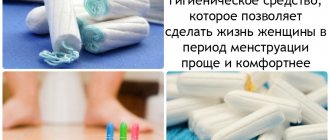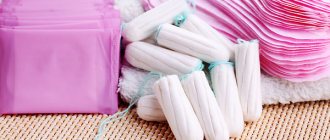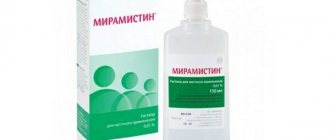Every girl, from a certain age, begins to use hygiene products during menstruation. Pads and tampons protect against leakage and secretions getting into your underwear. They allow the girl to live a quiet life without thinking about the consequences.
Over time, girls have a choice between pads and tampons. What is more convenient and how do they differ? Naturally, the choice remains with the girl herself and it is chosen individually. But it is worth considering each of the hygiene products against leakage separately.
What are gaskets
About 60-70% of women use pads. The product is easy to use and completely safe. They are reusable and disposable, depending on the material of manufacture. The second option is more preferable.
The rules of use are as follows:
- opening the package; release from the wrapper;
- sticking to underwear with a sticky layer;
- securing the wings, if any.
The pad is attached to the underwear
and is changed when it is full. However, it is not advisable to make a replacement later than after 5 hours. Available in different shapes and suitable for any underwear. A description of the types of gaskets is presented in the table.
| Daytime | Absorbent pads. They are marked on the package with 1-6 drops. When choosing, you need to rely on the number of allocations. |
| Night | Designed for use at night. They have a large absorbent area. Replaced after waking up. |
| Reusable | They have a tissue structure. Secure with a snap fastener. After use it must be washed. |
| Urological | Used for diseases accompanied by heavy discharge. |
All products have a similar structure. The top layer is made of fabric that is pleasant to the body. There is a sticky layer on the bottom (with the exception of reusable pads).
Gaskets can be purchased at a pharmacy or hardware store. The price is affordable. An additional flavor layer may be present.
You can buy everything you need at the pharmacy
What are the advantages and disadvantages
Gaskets have many more advantages than disadvantages. The positive qualities of the product include:
- range of sizes and degree of absorbency;
- accessibility of use;
- likelihood of night use;
- no discomfort during use;
- availability of individual packaging (not always);
- feeling of dryness when using;
- ease of disposal;
- affordable price.
The product can be used by virgins who are afraid to use tampons. The product is small in size and can always fit into a handbag.
There are also negative sides. When moving, the gaskets can make an unpleasant sound, reminiscent of the rustling of a bag. This will lead to incidents and complexes.
Using a gasket has its pros and cons
The product fits tightly to the genitals to protect against leakage. A greenhouse effect is created. An allergic reaction occurs in the form of itching and redness. If replacement is not done in a timely manner, a favorable environment for the development of various microorganisms appears.
Some products additionally contain fragrance. Such an additive often causes a strong reaction, which persists for some time after the end of the critical days.
The likelihood of negative aspects can be reduced only with correct application and selection. Take into account individual characteristics and adhere to recommendations.
About modern gaskets
They are made up of several layers, each of which solves its own problem. The bottom one is adhesive and is what is attached to the underwear. The next few layers are made of soft cellulose and polyethylene. The first absorbs menstrual fluid, the second prevents it from flowing beyond the pad. The top layer is in contact with the skin of the perineum and mucous membrane. There are many options for materials, but they are chosen so that the secretions do not come into contact with the body.
There are several types of pads, from which every woman can choose an acceptable option:
- Urological. Absorb a large volume of secretions and neutralize their odor, even with slight urinary incontinence;
- Nighttime. Longer and denser than others. They are enough for 8 hours of sleep;
- Daytime. Among them there are products with different absorption abilities, which are indicated on the packaging by drops;
- Reusable. They have a fabric top layer to avoid allergies, and replaceable internal parts.
Pros and cons of using gaskets
When choosing between pads or tampons, it is worth determining and evaluating the advantages of the first:
- A large selection of configurations and sizes, allowing you to choose a hygiene product for night time and for the day, heavy or scanty discharge;
- Easy to use. You don’t need special skills or experience to attach a hygiene product to your laundry;
- Comfort of use. A well-chosen pad does not interfere, absorbs discharge efficiently, leaving no chance for stains to appear on linen and clothes;
- Practicality. Most modern pads have separate packaging, and sometimes a case. And there is no need to carry the whole pack with you or hide one of them in a handkerchief for hygiene.
Like everything available in this world, pads have a number of disadvantages that can convince women to prefer tampons:
- They can be noticeable through clothing, and also make themselves known quite loudly by rustling when moving;
- Some women feel a “greenhouse effect”, despite the advertised “breathable” materials from which the pads are made, and claim that they are uncomfortable to move with;
- Despite regular replacement, they sometimes become a source of unpleasant odors, especially in hot weather. When the discharge comes into contact with air, it decomposes and can confuse the owner of the pad;
- It is more difficult to get rid of them when replacing them while you are away from home. The gasket cannot be flushed down the toilet, and in the trash can it will be visible to strangers due to its noticeable size. However, this aspect is not important for all women.
Choose a gasket and not make a mistake
In order for the advantages of a hygiene product to make your period easier and the disadvantages to be minimized, you should know what to look for when choosing it first of all:
- Material. The top layer should be breathable, and the rest should be supplemented with cotton wool and cellulose. The natural base will not allow the skin to experience discomfort in the form of itching, irritation, rashes;
- Size, shape and functionality. The first has implications for physical wearing comfort. It is best to choose an anatomical shape; such a pad will not feel like a baby’s diaper. The night one must be used exactly at this time of day. During the day, even with intense discharge, you should take those that are designed specifically for such cases;
- No fragrance. A perfumed surface can cause allergies and even harm the vaginal flora. In addition, using scented pads constantly can trigger an inflammatory or infectious disease, many of which are manifested by a change in the smell of menstrual discharge. The fragrance will not let you feel this.
What are tampons
Tampons were created later than pads. Used less often by women. They often cause fear in virgins who are afraid of damaging the pleura. However, if used correctly, this is impossible.
Intended for insertion into the vagina. They have a base and a thread for extraction. Advantageous due to ease of use.
When choosing tampons, you need to consider their size
Made from natural cotton or viscose. They are marked:
- mini;
- normal;
- super;
- super+.
When choosing, rely on the size of the vagina and the amount of menstrual flow. It takes several cycles to select the most convenient option.
used pads and tampons
I recently started using tampons and want to know if they are harmful. What do you think about using tampons? And how often can you use them? I was also alarmed by the fact that the instructions wrote about toxic shock syndrome, they assure me that this is not related to the use of tampons. Is this really true?
published 02/07/2013 12:50
- Women Health
Answered by Berezovskaya E.P.
You touched on a very interesting topic. I offer you a small piece from my new book, “The Intimate Book,” with a certain perspective on the past, so that you understand why tampons are still used by women and why most doctors still do not recommend them.
The first tampons were known back in Ancient Egypt. At that time, they were made from papyrus, which was simply rolled into a tube and inserted into the vagina. Such a tampon was inserted not for hygienic purposes, but for temporary “blockage” of the vagina in women planning to “go out” during menstruation. Basically, these were representatives of the Egyptian aristocracy. In Ancient Greece and then in a number of European countries, tampons were made from wool fibers (ordinary balls of woolen threads), grass, sponges, and when cotton appeared in the 19th century, tampons were made from pieces of cotton scraps that were always left after sewing clothes. In fact, making tampons at home was quite common, but such tampons were only used in cases where a woman needed to leave the house or attend to important work (or errands). And since there was no underwear in those days, tampons helped by preventing menstrual blood from staining skirts and running down the legs. However, I repeat that tampons were used very rarely and almost always secretly - inserting any objects into the vagina, including tampons, as well as touching the external genitalia with hands, was strictly prohibited in many religions, especially Christianity. Oddly enough, a tampon was created and patented for mass production by a man - Dr. Earl Haas from Denver (Colorado) in the years 1929-1931. He called them “catamenial remedies.” In modern medicine, the word “catamenial” is very rare and characterizes a disease (for example, epilepsy) that occurs on certain days of the menstrual cycle. In other words, the word “catamenial” translated from Greek meant “menstrual” or “menstrual.”
In 1934, Haas founded Tampax Sales Corporation. However, tampons were on sale before, that is, before the advent of Tampax. Fax, Holly-Pax, Modern Woman, Nunaps - these are the names of the first hygienic tampons available on the market in the 30s of the last century. The first tampons and sponges were extremely uncomfortable - they quickly leaked secretions, leaked, swelled, became deformed and often moved or fell out of the vagina. They were used most often by female athletes when menstruation appeared during competition. Tampax had an applicator with which tampons were easily inserted into the vagina, and a thread with which they were also easily removed. The word "Tampax" was a derivative of "tampon" and "vaginal pad". The success of Tampax was that, as a doctor, Haas involved the American Medical Association in advertising his innovation. A paid advertisement for Tampax appeared in the magazine of this professional organization, and another popular publication, The American Weekly, also wrote in a paid advertisement in 1936 that “your doctor will be the first to tell you that Tampax is the most natural (natural) and the best hygienic product for women, recognized by the American Medical Association." This was a lie because this association never acknowledged such a claim about tampons, but only published paid advertising for the company. However, such a misleading statement turned out to be another artificially created myth, which millions of women believed and still believe. Doctors began working for Tampax (unofficially), publishing articles in prestigious magazines of the time about the benefits and benefits of using new tampons, which increased Tampax's sales turnover significantly. Some authors have argued that tampon use improves erotic feelings in women, so such women are "sexually stimulated" by tampon use.
Although the introduction of tampons into the lives of women was accompanied by a certain opposition in society, the onslaught of some doctors who used the same quotes from advertising of the 40s had a significant impact on the widespread use of tampons, including by teenagers and virgin girls. Tampon advocates who worked for the company for a fee, such as Dr. Dickinson wrote in 1945 that “a virgin is one (a girl) who has never had sexual intercourse,” which means that the use of tampons does not deflower a girl, even if the girl breaks the hymen with a hard applicator. It turned out that it doesn’t matter whether a girl has a hymen or not, because supposedly this is not what determines virginity. Proponents of tampons still use these definitions of virginity, despite numerous data on damage to the hymen by applicators and tampons. Advertising for tampons has always included highlighting what were some of the downsides of using sanitary pads. For example, when the environmentalist movement began to grow, tampon manufacturers immediately began to put pressure on the public with the idea that sanitary pads pollute the environment, but small tampons are not only smaller in size, but also “environmentally friendly”, so they decompose faster and do not pollute the environment.
Another example relates to the passion of some young American women for sports: because of menstruation, many of them had to postpone participation in competitions. And then Tampax and similar companies attracted professional athletes to advertise tampons: tampons do not protrude or “see through” through sportswear and allow a woman to take part in sports, including swimming. The fact that playing sports during menstruation can negatively affect a woman’s health was not taken into account, nor was it mentioned anywhere or by anyone. In 1975, tampon advertisements explained their benefits simply: “Thanks to the tampon, I can wear a tight dress,” or tight tights, or a silk dress, or silk sexy lingerie, etc. Attention was paid to the desire of a woman to please the opposite sex, and if with the help of tampons this same sex may not even be aware of the presence of menstruation, and even touch and stroke a woman’s external genitalia, then isn’t this the best hygienic product? No one in the advertisement addressed the issue of the physiological outflow of menstrual blood, the increase in the level of infectious diseases of the vagina, diseases of the cervix, as well as the emergence of such a serious complication as “tampon” toxic syndrome. Why does tampon toxic shock syndrome occur? This serious complication was first discussed in 1978, when Dr. Philip Thiemo Sr. found a link between tampon use, especially at night, and toxic shock syndrome. The problem is that the tampon clogs the vagina and therefore does not allow the accumulated blood and dead pieces of the endometrium to come out, especially if the woman is in a horizontal position. These wastes not only accumulate between the tampon and the cervix, but with a reduced amount of oxygen (due to the tampon, much less oxygen enters the vagina), they create conditions for the growth of bacteria that produce toxic substances. During the natural (physiological) outflow of menstrual blood, it accumulates on the sanitary pad outside the internal genital organs. However, when using tampons, blood is not only adsorbed by the tampon, but also accumulates between it and the vaginal portion of the cervix. So far, no woman has died from using sanitary pads. Despite warnings about toxic shock syndrome due to the use of tampons, deaths due to shock are still being reported around the world.
The American Food and Drug Administration (FDA) has created recommendations for the prevention of toxic shock syndrome. According to them, women should take into account the degree of adsorption of tampons in accordance with the amount of menstrual flow, not use synthetic tampons (from the region), but give preference to cotton or fabric ones; change tampons every 4-6 hours, use sanitary pads and tampons alternately, do not use tampons at night or while sleeping. Unfortunately, many women, especially young girls, are still not familiar with such recommendations.
Modern advertisements for tampons are absolutely no different from those used in the 40s and 50s, including by doctors. And this advertising works, especially with teenagers and young women, just as it has worked for the last 50-60 years. If in the 20-30s tampon advertisements were more common in publications for women, over the last 30-40 years such advertisements have been published most often in publications for teenagers (Seventeen, YM, Teen, etc.). Young teenage girls, who often do not analyze what is happening, are easier to manipulate. The pads their mothers use seem outdated and unfashionable to the younger generation, while a tampon can be hidden in a purse or even a pocket (and advertising also focuses on this), although most do not know that tampons have been on the market for almost a century. Many girls also do not know that most often they use synthetic tampons made in their area (artificial cellulose), rather than cotton, and this also has its negative impact on the vaginal microflora. Our post-Soviet women are not only limited in receiving modern, reliable information, but are also very easily influenced by all sorts of crooks, modern-day Ostap Benders, especially if they are of “foreign origin.” We will talk about a number of network companies. Most of them are not registered or licensed at all, much less in Russia, Ukraine and a number of other former republics, but they successfully impose “miracle drugs” on our people, panaceas for almost all female or male diseases, including hygienic ones pads and sanitary tampons. It is interesting that most often it is men, not women, who sell these “miracle goods”. Perhaps it’s easier to deceive them, because they have almost no knowledge about the structure and functioning of the female reproductive system, which means it’s not difficult to introduce a program into their brains about the benefits of pads or tampons. Either they are tired of the complaints of their wives and mistresses about various kinds of “sores,” discharge, and reluctance to have sex.
Where exactly the next “tampon scam” originated is unknown, but Chinese “scientists” are involved in one that has begun to spread among our people. The worst thing is that residents of the former Soviet republics do not understand that all Chinese scientists and doctors have received and are receiving payment and reward, in fact working for network companies to create false theories mixed with biochemical and biophysical terminology. And these false theories about the “ionic action of super-pads or tampons,” which supposedly treat all women’s diseases without exception, act like a drug, especially on the brains of those women for whom doctors successfully pin diagnoses on their ears, intimidating them with this and that, pumping at the same time, money for their “useful” services. There are also doctors who understand that they can make money by selling Chinese tampons, since there is not enough medical knowledge, but they want to receive a reward from the next victim who has successfully intimidated them.
You must understand a simple truth: there are many diseases of the female reproductive system, and they all have a different nature of origin, and therefore require a completely different approach to diagnosis and treatment. This means that there cannot be one universal treatment for all diseases. Just as it is impossible to cure herpes with diuretics, or pneumonia with laxatives, it is impossible to cure female diseases with tampons or pads alone. Do not believe deceptive advertising, because it is aimed specifically at people who are illiterate in relation to health, do not think, are easily controlled and manipulated. Chinese tampons and pads or the like are an ordinary scam of network companies, where there is no honesty and integrity of the manufacturer, just as there is no honesty and integrity of all those specialists in white coats who work for the companies and therefore create false advertisements.
https://www.komarovskiy.net/faq/o-bezopasnosti-tamponov-i-sindrome-toksicheskogo-shoka.html
What are the disadvantages and advantages
Tampons are considered underrated. The product has a number of advantages:
- not noticeable when wearing even tight-fitting clothes;
- completely protect against possible leaks;
- are not accompanied by a greenhouse effect;
- used when swimming in the sea or pool;
- protects against the unpleasant smell of blood.
The product has a compact size. Each tampon is individually packaged. Sterility is maintained until opening.
Sometimes you are allergic to tampons
The disadvantages include:
- probable discomfort during the first time after starting use;
- the need for frequent replacement;
- the likelihood of developing allergies;
- the risk of developing toxic shock with rare replacement;
- negative impact on natural microflora;
- prohibition on use for inflammation;
- prohibited use at night.
Disadvantages can be avoided with proper use and frequent replacement.
Tampons
To understand what is better to use, tampons or pads, you need to consider that modern hygiene products have both advantages and disadvantages. Only after carefully studying them can you choose certain products.
pros
Many women are of the opinion that it is better to use tampons instead of pads. This is due to the fact that these intimate hygiene products have a number of advantages:
- invisible under clothes;
- do not leak;
- the skin is not irritated;
- you can choose a tampon with an applicator that ensures its correct insertion;
- You are allowed to enter the pool with a tampon. There is only one limitation - you need to be in the water for no more than twenty minutes, immediately after leaving you need to replace the hygiene item .
Minuses
The disadvantages of tampons are as follows:
- the process of introducing a hygiene product at first causes difficulties;
- it is possible that it may occur during excessively active movements;
- The product can dry out the mucous membrane with constant use. For this reason, there is a risk of infectious disease of the genital organs;
- by limiting the access of oxygen, an environment favorable for the development of bacteria is created;
- It is not recommended to use tampons at night;
- need to be replaced every 2–3 hours;
- there is a risk of toxic shock.
What are the features of choice?
Both products are easy to use. When choosing, it is better to take into account individual characteristics. You can additionally consult with your doctor. Consider the amount of discharge that comes out during menstruation. Consider your plans for the period when you have your period. Tampons, for example, are better to choose when going to the sea, since the product does not peek out from under your panties and can be used when swimming.
Choose only high-quality pads and tampons. They must be made from natural fabrics. It is better to purchase at a pharmacy rather than household stores. Individual packaging must not be printed prior to use.
What's best for a virgin?
There is a misconception that virgins are strictly prohibited from using tampons.
Not really. If the virgin pleura is intact, choose products marked mini. This product has a minimum size. Read also: pros and cons of using tampons in girls.
Tampons or sanitary pads: what to choose? You will learn about this from this video:
Mini tampons are 1 cm in size. The product is placed into the hole in the virgin pleura without damaging it.
Doctors recommend that teenagers not overuse tampons. It is better to wear pads at first. The product is easy to change and does not require compliance with a number of rules when using.











